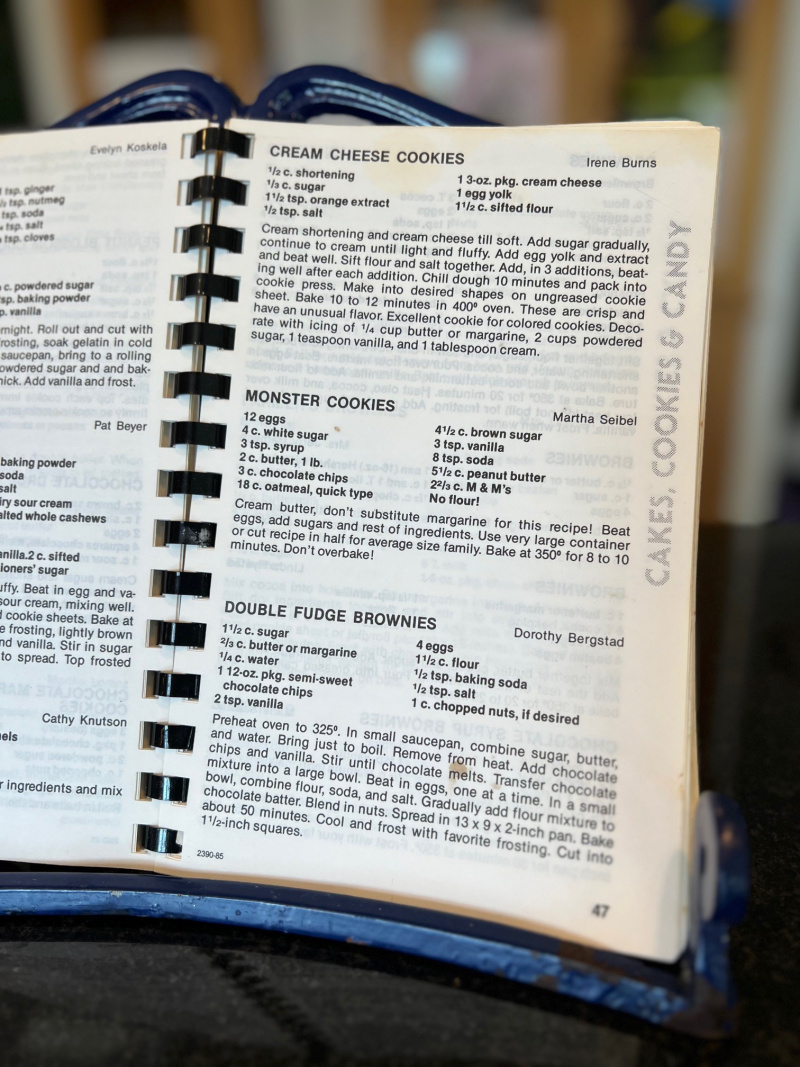Rationale
As my daughter was disappointed in the two previous dishes, I tried to re-engage her interest in my project at the start of the summer. I let her choose a sweet recipe to make for her grandparents to eat during the break in her busy day of dance and piano recitals in May. She chose Martha Seibel’s “Monster Cookies” (Cakes, Cookies, & Candy), which sounded great to me.
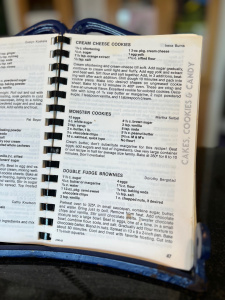
We tackled this early on a Friday evening, with the intention of making Martha Seibel’s “Wild Rice & Chicken Casserole” (Main Dishes & Casseroles) for dinner after getting the cookies in the oven. Well, that did not happen.
Size
This recipe was huge, temporally, spatially… really, in every way! Martha advises the cook to “use [a] very large container or cut recipe in half for average size family.” While I’m not sure what an average size family is, I undoubtedly have a less-than-average-size family, given the pronatalist microaggression I encounter as the mother of one child (for more information, see my recent publication: https://demeterpress.org/books/maternal-regret-resistances-renunciations-and-reflections/). Thus, I decided to cut it in half immediately.
As you can see from the recipe, a half-batch of monster cookies still included ample ingredients: 6 eggs, 2 cups of white sugar, 1 cup of butter, 9 cups of oatmeal, 2 ¼ cups of brown sugar, 2 ¾ cups of peanut butter, and almost 3 cups of M&M’s and chocolate chips combined. But there was “no flour!” Martha includes that directive specifically in the list of ingredients to ward off the questioning phone calls she was sure to receive when others started making the recipe at home. Very wise, indeed! The mixture became so large, I had to transfer it from my largest Pyrex bowl to the largest bowl in our kitchen. Thank goodness Luke came home while we baking, because we use our largest bowl so rarely that we keep it on the top of the kitchen cupboards, and I both forget we have it because I cannot see it and cannot reach it as easily as he can.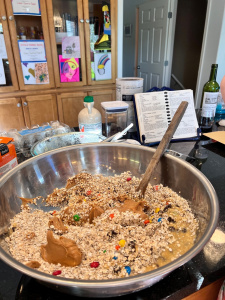
Dough
While the recipe did not indicate whether to use an electric mixer or not, I hand-mixed (not literally—I used a long olive-wood spoon) the dough for two reasons: 1) it became clear that it was going to be too big to go in the mixer; and 2) I did not want to mince oatmeal and make the dough too smooth. Monster cookies should have a chunky texture (I remember a middle-school home economics monster-cookie situation with very smooth dough—still delicious, though). However, the amount of the ingredients made this an athletic endeavor! If I ever make the recipe again, I would be sure to mix the “wet” ingredients with my mixer and then add in the chunkier pieces by hand—the oatmeal, chocolate chips, and M&M’s, much like when I make blondies. But nine cups of oatmeal (over ¾ of a tall cylinder package!), would make most people’s arms tired. The Baby liked the dough, despite our warning that this type of dough might not be yummy, given the amount of uncooked oatmeal.
Baking
The only instructions regarding the transfer to the oven were the temperature, timing, and what I interpreted as a friendly admonition: “Don’t overbake!” This raised many questions for me: how am I to drop the cookies? Should they be flat? Balls? What size? I had no idea. So we experimented with each cookie sheet, first dropping very big round balls.
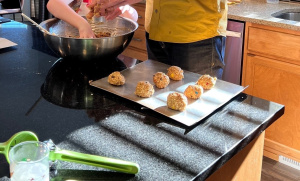
But when checking on them in the oven, three minutes into the 8-10 specified, they looked like they had just been put on the sheet—still round and pale. At ten minutes, they were flatter, but still pale. At 16 minutes, they were closer. After another five, we took them out, and the top rack’s sheet was browner than the bottom; we moved the lower pan to the top to brown for a minute. The cookies on both sheets crumbled easily and were difficult to transfer to the cooling racks. Perhaps we overbaked!
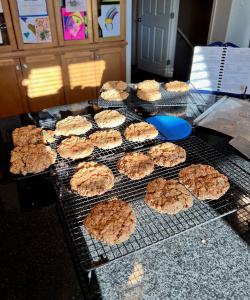
Our second sheet featured slightly smaller balls, which took slightly less time. Our third sheet used large scoops again, but we flattened them. At this point it was getting late, but there was still a lot of dough left, which reminded me why I prefer making bars. Luke must have been thinking the same thing, because he said, “It seems like you could have just made a flat sheet pan of these.” So we did! I put the rest of the dough in a nine-inch cake pan and baked for about 14 minutes. We ended up going out to eat, as it was much too late to start a casserole. When we returned, we packed the cooled cookies into about six containers; the size of each cookie and the batch meant we had quite a stack of containers. Clearly, I need to invest in some new baked-good storage.
Tasting
During mixing, we had joked about how so much oatmeal made these suitable for breakfast, and so our daughter “made” breakfast—a cookie and fruit for each of us. They were a bit hard and very crumbly. On Sunday, we fed the cookies to the grandparents, as planned. On Tuesday evening, I was sick of the stack of containers and knew the shelf life was up, but before I tossed them, the Baby and I cut wedges from the bars. Amazingly, they were delicious—gooey and moist, even four days after baking! The Baby said, “So triangles are better than circles.” She’s right. Our verdict? Make a pan of bars, using one fourth of the specified amounts.
Writing
I love the writing style of this recipe! Whether intentional or not, the comma splices add urgency (who has time for grammatically separate imperatives? Not Martha, and not me), and the direct address is engaging. I feel like I can hear her speaking directly to me: “Don’t substitute margarine for this recipe! (music to my ears!)…Don’t overbake!…No flour!” While Martha’s use of three exclamation points means two journalists never get to use their lifetime allotments 😊, I fully support this punctuation usage, as a grammarian attuned to the gendered reading of texts and a fond supporter of the exclamation mark (for more fun on this topic, I recommend Amanda Montell’s Wordslut and https://www.theatlantic.com/technology/archive/2018/06/exclamation-point-inflation/563774/, to start).
But as is evident from the difficulties we encountered during baking, the instructions make assumptions. While formal definitions of “cream” allow for beating of butter by itself, most cooking usage of “cream” assumes a second ingredient as requisite (typically sugar). Do you beat the eggs separately? When do you add them to the butter? Or are the eggs, sugars, and rest of ingredients mixed separately, then added to the butter? That seems unlikely, but a strict reading of instructions could foster that interpretation. Should the cookie sheet or other pan be greased? Other than the named butter, eggs, and sugars, does the order of adding ingredients matter? Why are the typical “last” ingredients like chocolate chips, oatmeal, and M&Ms not listed together in the columns? Perhaps the baker in 1985 would have implicitly understood.
Contributor
Martha Seibel was born in 1930 in Voltaire, ND, to Jorgen and Mabel Aaseth, the oldest of seven children, and married Wilbert Seibel (b. 1925) in 1949 at Oak Valley in Velva. They farmed south of Velva, and had two children, Mark and Wanda. Martha became a social worker in her 50s and was very active in community organizations and Oak Valley Lutheran. She passed at the age of 90 in 2020. She was an active contributor to The Joy of Sharing, as well; her eleven contributions include the aforementioned chicken wild-rice casserole, “Strawberry Nut Bread,” “Yule Kage,” “Oatmeal Cake,” “Peanut Blossoms,” “Mom’s Lefsa (Old Fashioned Type),” Easy Romegrot” (as Marth Seibel—I’m assuming this is a proofreading error), “Lo-Cal Hot Dish” (love the pun here—I’m definitely going to try this, though I’m not sure grammar and usage irreverence is the best reason to select a recipe), “Taco Salad,” and “To Preserve Your Christmas Tree” published in the “This & That” section.
This post is part of an ongoing series in which I make and reflect on recipes and the people who contributed them to the 1985 Oak Valley Lutheran Church compiled cookbook, The Joy of Sharing.

